The structure of the research work. General rules for writing and structure of research work. Research Objective Statement
Traditionally, a certain compositional structure of research work has developed, the main elements of which in the order of their arrangement are as follows: 1. Title page 2. Table of contents 3. Introduction 4. Chapters of the main part 5. Conclusion 6. Bibliographic list 7. Appendices Title page is the first page of research and development and is filled in according to strictly defined rules. After the title page is placed table of contents, in which all the titles of the research work are given and the pages from which they begin are indicated. Table of contents headings should exactly repeat the headings in the text. Introduction. It usually substantiates the scientific novelty and relevance of the chosen topic, the purpose and content of the tasks, the object and subject of the research is formulated, the chosen method (or methods) of research is indicated, and what is the theoretical significance and applied value of the results obtained. The scientific novelty of the research work gives the author the right to use the concept "For the first time" when characterizing the results obtained, this means the absence of such results before their publication. Scientific novelty is manifested in the presence of theoretical propositions, which were formulated for the first time and substantively substantiated, methodological recommendations, which were introduced into practice and have a significant impact on the development of science as a whole and its individual directions. The relevance of the topic is assessed from the point of view of modernity and social significance, a problematic situation is created, a way out of which you propose. In order to inform the reader of the research work about the state of development of the selected topic, short review literature, which ultimately should lead to the conclusion that this particular topic has not yet been disclosed (or disclosed only partially or in the wrong aspect and therefore needs further development). A review of the literature on the topic should show a thorough acquaintance with special literature, the ability to systematize sources, critically examine them, highlight the essential, evaluate what was previously done by other researchers, and determine the main thing in the current state of study of the topic. All publications of any value that are directly and directly related to the topic of research and development should be named and critically evaluated. From the formulation of a scientific problem and proof that that part of this problem, which is the topic of research, has not yet received its development and coverage in the special literature, it is logical to go to the formulation the objectives of the research undertaken, and also indicate the specific tasks to be solved in accordance with this goal. This is usually done in the form of an enumeration (study ..., describe ..., install ..., identify ..., derive a formula, etc.). The formulation of these tasks must be done as carefully as possible, since a description of their solution should form the content of the chapters of research. This is also important because the titles of such chapters are "born" precisely from the formulations of the objectives of the research undertaken. An obligatory element of the introduction is the wording object and subject of research. An object is a process or phenomenon that generates a problem situation and is selected for study. A subject is what is within the boundaries of the object. The object and the subject of research as categories of the scientific process are related to each other as general and particular. The part of the object that serves as the subject of research is highlighted. It is to him that the main attention is directed, it is the subject of research that determines the topic of research, which is indicated on the title page as its title. A mandatory element of the introduction is also an indication of research methods, which serve as a tool in the extraction of factual material, being necessary condition achieving the goal set in such work. The introduction also describes other elements of the scientific process. These include, in particular, an indication on which specific material the work itself was performed. It also provides a description of the main sources of information (official, scientific, literary, bibliographic), and also indicates the methodological basis of the study. In chapters main part of researchthe research methodology and technique are considered in detail and the results are summarized. All materials that are not vital for understanding the solution of a scientific problem are included in the appendices. The content of the chapters of the main part should exactly correspond to the research topic and fully disclose it. These chapters should show the ability to concisely, logically and reasonably present the material. R&D ends the final part, which that's what the "conclusion" is called. Like any conclusion, this part of the research work plays the role of an ending conditioned by the logic of the research, which is in the form of a synthesis of the scientific information accumulated in the main part of it. This synthesis is a consistent, logically coherent presentation of the results obtained and their relationship with the general goal and specific objectives set and formulated in the introduction. It is here that the so-called "derivative" knowledge is contained, which is new in relation to the original knowledge. This deductive knowledge should not be replaced by a mechanical summation of conclusions at the end of chapters that present a brief summary, but should contain something new, significant, which makes up the final results of the study, which are often framed in a number of numbered paragraphs. Their sequence is determined by the logic of the study design. At the same time, not only its scientific novelty and theoretical significance, but also its practical value, arising from the final results are indicated. After the conclusion, it is customary to place bibliographic list of used literature. This list is one of the essential parts of research and development and reflects independent creative work. Each literary source included in such a list should be reflected in the text. If the author makes a reference to any borrowed facts or cites the works of other authors, then he must indicate in the subscript where the materials are taken from. You should not include in the bibliographic list those works that are not referenced in the text, and that were not actually used. It is not recommended to include encyclopedias, reference books of popular science books, newspapers in this list. If there is a need to use such editions, then they should be cited in footnotes. Auxiliary or additional materials that clutter up the text of the main part are placed in application.In terms of content, applications are very diverse. These, for example, can be copies of original documents, extracts from reporting materials, production plans and protocols, individual provisions from instructions and rules, previously unpublished texts, correspondence, etc. In form, they can be text, tables, graphs, maps. The appendices must not include a bibliography of used literature, auxiliary indexes of all kinds, reference comments and notes that are not appendices to the main text, but elements of a reference and accompanying apparatus that help to use its main text.Each appendix must begin on a new sheet (page) with indicating in the upper right corner of the word "Application" and have a thematic title. If there is more than one annex, they are numbered with Arabic numerals (without a No. sign), for example: "Appendix I", "Appendix 2", etc. The pagination of the pages on which the appendices are given should be continuous and continue the general pagination of the main text. The link between the main text and the annexes is through links that are used with the word "look"; it is usually abbreviated and enclosed, together with the code, in parentheses in the form: (see Appendix 5).
The next step is to review each of the sections from the beginning. Ideally, you should limit yourself to working in small sections of five pages at a time. After these short sections, your eyes get used to your writing and your effectiveness in spotting problems diminishes. Revision is a difficult but rewarding skill that academic writers learn with years of practice. As opposed to revising a macrostructure, which is a linear process and is usually done with detailed description and chapters, microstructure revision is a non-linear process.

Research structure
Table of contents Introduction Main part Conclusion List of references application
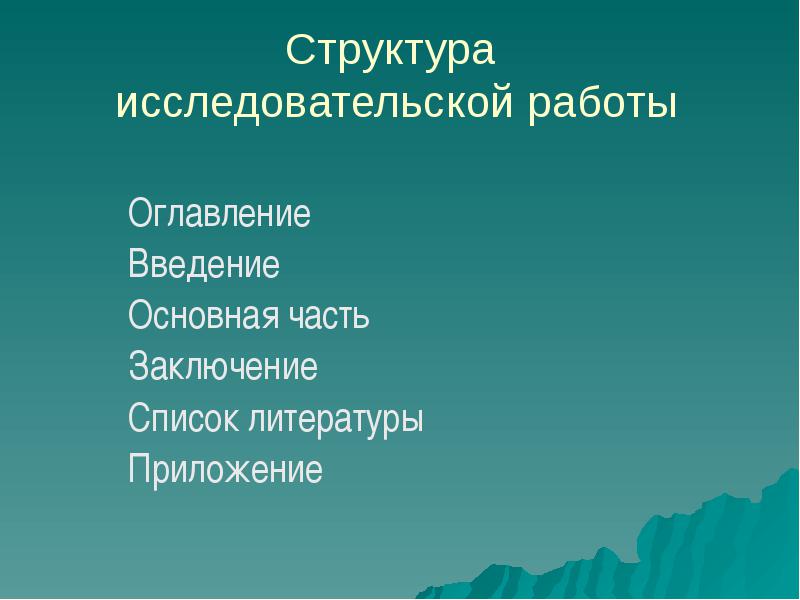
Sample title page design
Main part Conclusion List of references application

Sample title page design
List of references application

Sample title page design

Sample title page design
X city scientific-practical conference of schoolchildren
While the goal of macro structure revision is to analyze your ideas and their logic, the goal of microstructure editing is to carefully examine the shape of your ideas: your paragraphs, sentences, and words. You do not need or advise to follow the paper order for this type of revision. You can start from the end or from different sections. You can even revisit by reading back sentences, sentence by sentence, and word by word.
One strategy for rethinking the microstructure, often used in consultation with a writing center, is to read the newspaper aloud. You can read aloud to yourself, a tape recorder, or a colleague or friend. As you read and listen to your paper, you will most likely notice places where the escape is disrupted and where you stumble due to a very long and fuzzy sentence or a wrong connector.
Section: biology
Topic: "The effect of antimony on the germination of cereal seeds"
Work place:
nevinnomyssk
MOU secondary school number 12, grade 11.
Academic Supervisor: Petrova
Irina Vladimirovna, teacher
biology, MOU SOSH № 12
Nevinnomyssk, 2011 
Sample table of contents
Another revision strategy is to find out your common mistakes and do targeted searches for them. All authors have a set of problems specific to them, i.e. their characteristic features. Remembering these issues is just as important to an academic writer as remembering your friends' birthdays. Create a list of these features and search for these issues with a word processor. If you have a problem with intensifiers, search for "really" or "very" and remove them from the text.
The same targeted search can be done to eliminate verbosity. The final strategy works with paper and pencil. Print a double copy in font size 14 and re-read your paper in a few steps. Try to read your paper line by line, the rest of the text will be covered with a sheet of paper. When you are forced to see only a small portion of your letter, you are less likely to be distracted and more likely to notice problems. At the end, you will find more unnecessary words, misspelled phrases, or non-parallel constructs.
Table of contents page
Introduction…………………………………………………………………………………3-4
Chapter 1. Cerium, its properties, receipt and application.
1.1. The history of the discovery and production of cerium ……………………………… .5
1.2. Cerium deposits ……………………………………………………… .5-6
1.3. Cerium properties …………………………………………………………………… .6
Once you've applied all of these strategies, you're ready to share your letter with your friends, colleagues, and a writing consultant in the center of the letter. Get as much feedback as possible, especially from non-experts in your field. Listen patiently to what others have to say to you - you don't have to defend your letter or explain what you have to say. You can decide what you want to change and how after getting feedback and sorting in your head. Although some researchers make revision an endless process and can hardly stop after the 14th project; five to seven drafts of your article is the norm in the sciences.
1.4. Obtaining cerium ……………………………………………………………… .7-8
1.5. Application of cerium …………………………………………………………… .8-9
Conclusions on the first chapter ………………………………………………………… .9
Chapter 2. Experimental production of cerium
and experiences with him.
2.1. Isolation of rare earth metals from the alloy ……………… .10
2.2. Separation of cerium and lanthanum compounds .............................................. 10
Get feedback and go again
If you can't stop reviewing, then set a deadline for yourself and stick to it. You are still in your lab, finishing audits and preparing to file your document. You feel happy - you finally finished the job in a year. You will submit your document tomorrow, and regardless of the outcome, you know you can do it. If one magazine does not take your paper, you will use feedback and resubmit again. You will have a publication and this is the most important achievement.
2.3. Reactions characteristic of cerium and lanthanum compounds .......................................... ...............................ten
2.4. Research results ………………………………………………… ..10-11
Conclusion ……………………………………………………………………………… .11-12
Literature ……………………………………………………………………………… ..12
Appendix ……………………………………………………………………………… .13-17 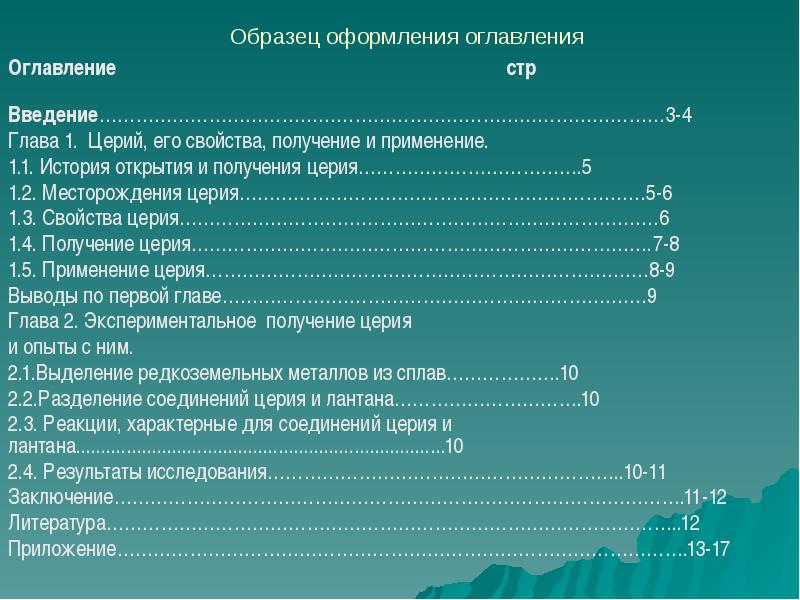
More importantly, you have a scheduled recording time that you intend to keep in your future publications, for reading and taking notes, for writing grants, and for reviewing documents. This time you will not lose stamina and you will become a productive scientist. But for now, let's celebrate the end of the article.
Structure and logic of research work
Pleasant music overcomes the loss of awareness in patients with visual neglect. The basics of writing biomedical research. 2nd edition. The use of native and non-native writers of first-person pronouns in different sections of biology research articles on english language... Active voice in scientific articles: functions of frequency and discourse. On the use of passive in two astrophysics journals with extensions to other languages \u200b\u200band other areas. Writing in the sciences: exploring the conventions of scientific discourse. Academic writing for graduate students. 2nd edition. How to write an effective discussion. Journal Article Writing in 12 Weeks: A Guide to Academic Publishing Success. Demystification of thesis: streamlined process of choosing a topic for the final text. Detection, diagnosis and revision strategies. Q: Instructor's Guide: One-to-One Writing Help. Can you confirm this? p. 140-.
- Q: The Science of Writing: Theories, Methods, Individual Differences and Applications.
- Scientific writing and communication.
- Documents, proposals and presentations.
Introduction
The relevance of research
Purpose of the study
Object of study
Subject of study
Research objectives
Research methods
Hypothesis
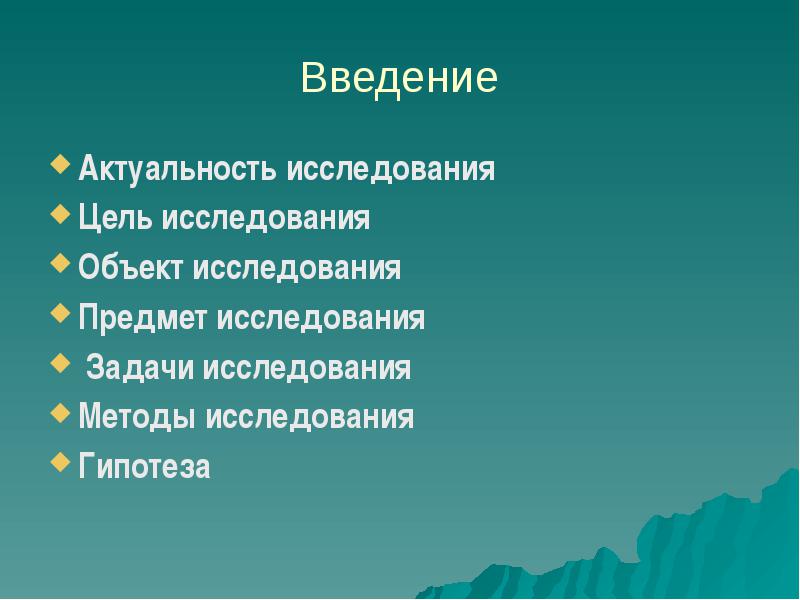
The relevance of research
This means explaining the need to study the topic.
It should be indicated why exactly it is and exactly at the moment is relevant.
It is necessary to highlight the reasons why the study of this topic became necessary.
An undoubted indicator of relevance is the presence of a problem in this area of \u200b\u200bresearch.
You can imagine the problem as a kind of contradictory situation that requires its resolution.
When addressing a particular problem, the researcher needs to clearly imagine what questions the results of his work can answer.
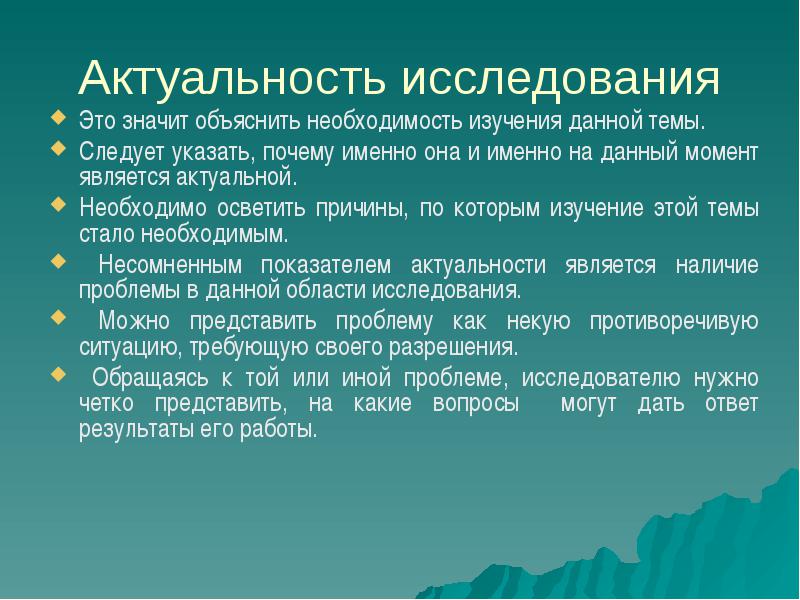
Purpose of the study
This is the end result that the researcher would like to achieve when completing his work.
Typical goals: to characterize previously studied phenomena; identifying the relationship of certain phenomena; study of the development of phenomena; description of a new phenomenon; generalization, identification of general patterns; creation of classifications
Research Objective Statement:
- identify ...;
- install ...;
- justify ...;
- clarify..;
- develop ...

Object and subject of research
The object of research is a certain process or phenomenon that generates a problem situation. An object is a kind of bearer of the problem - what the research activity is aimed at.
The research subject is a specific part of the object within which the search is conducted. The subject of research can be phenomena as a whole, their individual aspects, aspects and relations between individual parties and the whole.
It is the subject of research that determines the topic of the work.
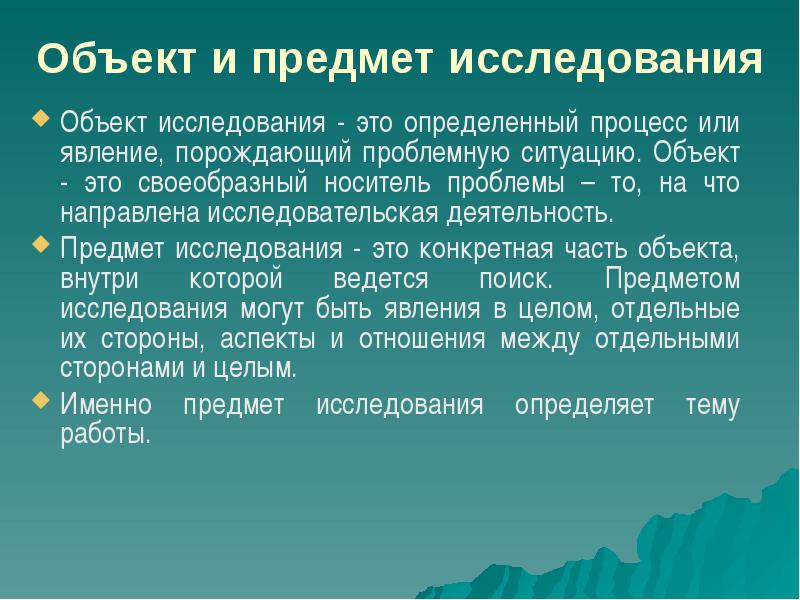
Research objectives
Research objectives are the choice of ways and means to achieve the goal.
Objectives are best formulated as statements of what needs to be done to achieve the goal.
The statement of tasks is based on the division of the research goal into subgoals.
The list of tasks is based on the principle of simple tothe most difficult, time consuming.
The number of tasks is determined by the depth of research, but not less than 2.
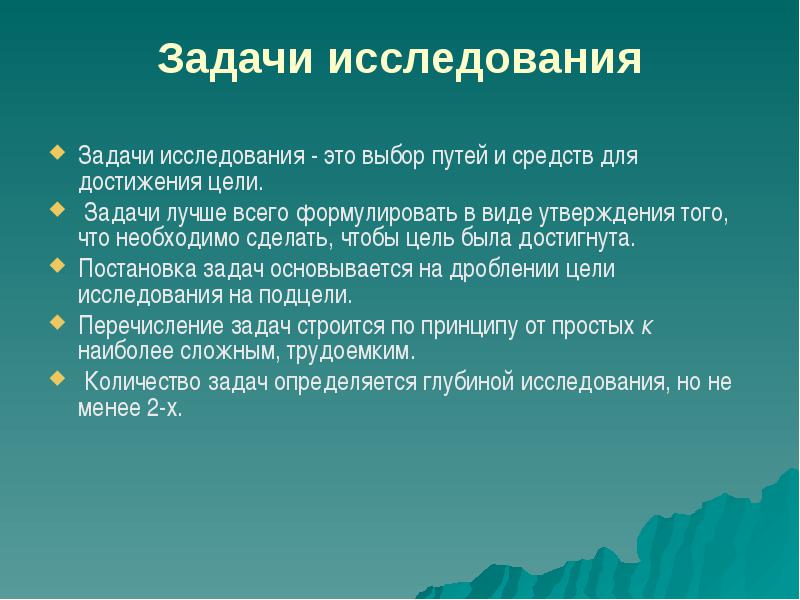
Research methods
Theoretical methods:
-
modeling -
abstraction - analysis and synthesis - climbing from the abstract to the concrete
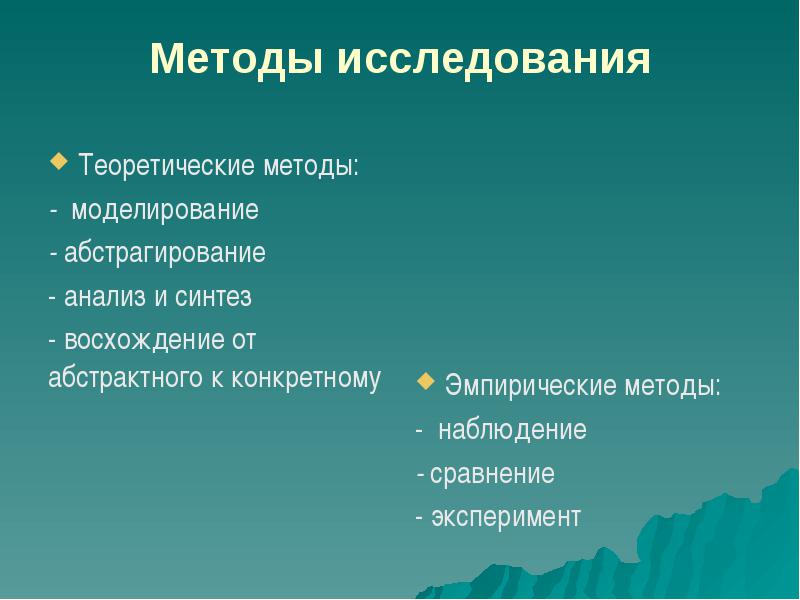
Mathematical methods:
- statistical methods;
-
methods and models of graph theory and network modeling;
- methods and models of dynamic programming;
- methods and models of queuing;
-
data visualization method (functions, graphs, etc.).

Hypothesis
must meet a number of requirements:
1
be verifiable; 2 contain a guess; 3 be logically consistent; 4
fit the facts. 5 can begin with typical verbal constructions: "if ... then ..."; "So ... like ..,", "provided that, ..",
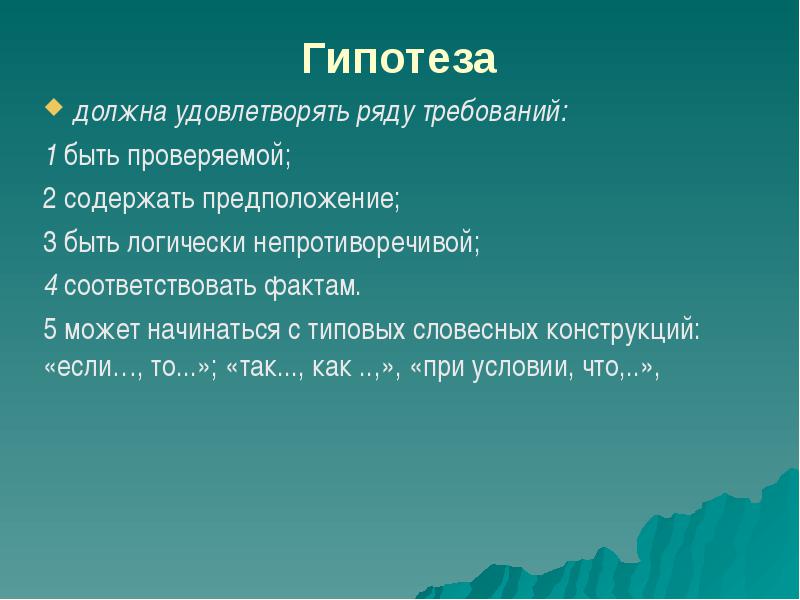
Main part
The first chapter reveals the history of the issue under study, presents various methodological and theoretical foundations of the problem under study.
The second chapter highlights practical research, accumulated practice and experience, revealed contradictions and incomprehensible, controversial points, recommendations.
In the title of the paragraphs of the second chapter, it is desirable that the words "experimental research", "organization and methods of research"
The results of the study describe the findings. It is advisable to present them in the form of tables, graphs, diagrams, diagrams.
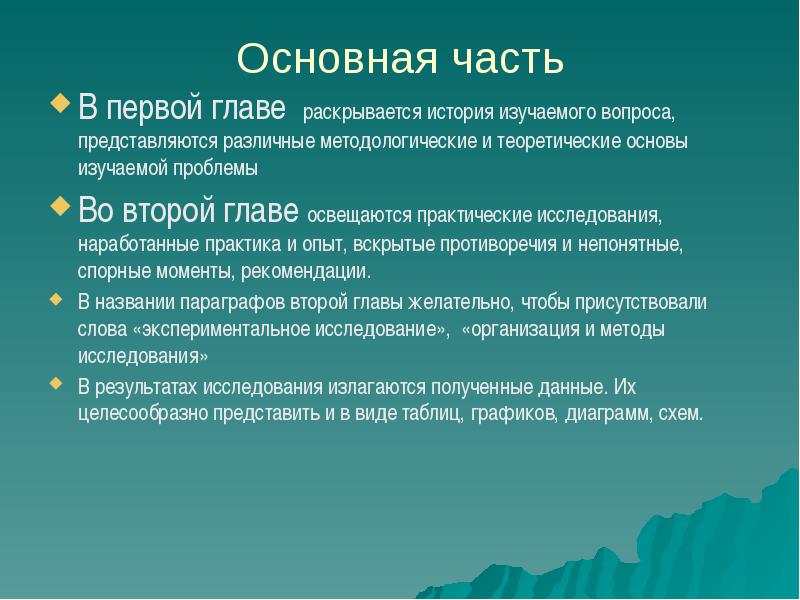
Conclusion
in a concise form, the conclusions and results obtained by the author are formulated, indicating, if possible, the directions for further research and proposals for the possible practical use of the research results.
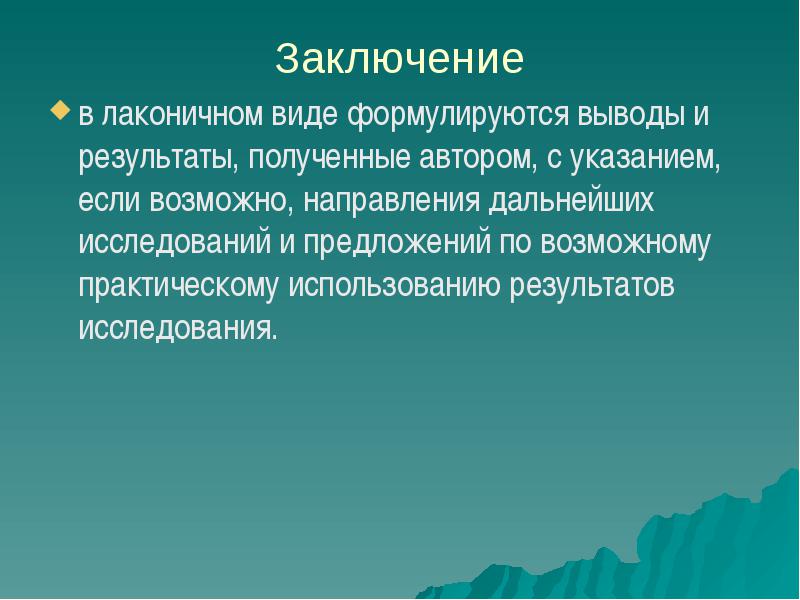
list of references
publications, editions and sources used by the author are entered, which should be at least 5-10 sources.
Information about each publication should include in strict sequence: the name, initials of the author, title of the publication, imprint of the publisher, year of publication, issue number (if the publication is periodic), number of pages. All publications should be numbered and sorted alphabetically.

attachment
Appendices should be drawn up as a continuation of the work on its subsequent pages in the form of a separate book. Each application should start on a new page and have a title with the word “Application” and its designation at the top-middle of the page.
If there is more than one application, then they are indicated by Arabic numerals. Applications should be placed in the order in which links to them appear in the text. Each application starts on a new page.
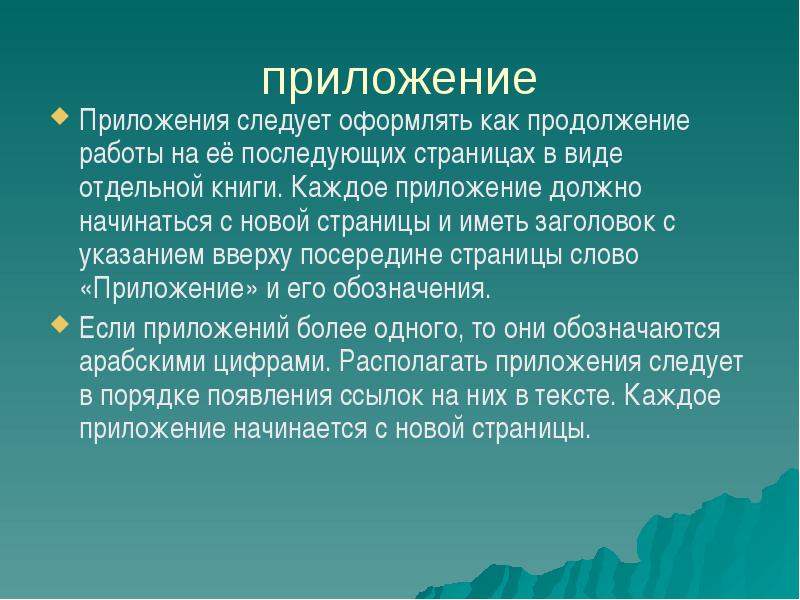
Graphic material
Theoretical methods:
-
abstraction - analysis and synthesis - climbing from the abstract to the concrete

Mathematical methods:
- statistical methods;
-
methods and models of graph theory and network modeling;
- methods and models of dynamic programming;
- methods and models of queuing;
-
data visualization method (functions, graphs, etc.).

Hypothesis
must meet a number of requirements:
1
be verifiable; 2 contain a guess; 3 be logically consistent; 4
fit the facts. 5 can begin with typical verbal constructions: "if ... then ..."; "So ... like ..,", "provided that, ..",

Main part
The first chapter reveals the history of the issue under study, presents various methodological and theoretical foundations of the problem under study.
The second chapter highlights practical research, accumulated practice and experience, revealed contradictions and incomprehensible, controversial points, recommendations.
In the title of the paragraphs of the second chapter, it is desirable that the words "experimental research", "organization and methods of research"
The results of the study describe the findings. It is advisable to present them in the form of tables, graphs, diagrams, diagrams.

Conclusion
in a concise form, the conclusions and results obtained by the author are formulated, indicating, if possible, the directions for further research and proposals for the possible practical use of the research results.

list of references
publications, editions and sources used by the author are entered, which should be at least 5-10 sources.
Information about each publication should include in strict sequence: the name, initials of the author, title of the publication, imprint of the publisher, year of publication, issue number (if the publication is periodic), number of pages. All publications should be numbered and sorted alphabetically.

attachment
Appendices should be drawn up as a continuation of the work on its subsequent pages in the form of a separate book. Each application should start on a new page and have a title with the word “Application” and its designation at the top-middle of the page.
If there is more than one application, then they are indicated by Arabic numerals. Applications should be placed in the order in which links to them appear in the text. Each application starts on a new page.

Graphic material
- climbing from the abstract to the concrete

Mathematical methods:
- statistical methods;
-
methods and models of graph theory and network modeling;
- methods and models of dynamic programming;
- methods and models of queuing;
-
data visualization method (functions, graphs, etc.).

Hypothesis
must meet a number of requirements:
1
be verifiable; 2 contain a guess; 3 be logically consistent; 4
fit the facts. 5 can begin with typical verbal constructions: "if ... then ..."; "So ... like ..,", "provided that, ..",

Main part
The first chapter reveals the history of the issue under study, presents various methodological and theoretical foundations of the problem under study.
The second chapter highlights practical research, accumulated practice and experience, revealed contradictions and incomprehensible, controversial points, recommendations.
In the title of the paragraphs of the second chapter, it is desirable that the words "experimental research", "organization and methods of research"
The results of the study describe the findings. It is advisable to present them in the form of tables, graphs, diagrams, diagrams.

Conclusion
in a concise form, the conclusions and results obtained by the author are formulated, indicating, if possible, the directions for further research and proposals for the possible practical use of the research results.

list of references
publications, editions and sources used by the author are entered, which should be at least 5-10 sources.
Information about each publication should include in strict sequence: the name, initials of the author, title of the publication, imprint of the publisher, year of publication, issue number (if the publication is periodic), number of pages. All publications should be numbered and sorted alphabetically.

attachment
Appendices should be drawn up as a continuation of the work on its subsequent pages in the form of a separate book. Each application should start on a new page and have a title with the word “Application” and its designation at the top-middle of the page.
If there is more than one application, then they are indicated by Arabic numerals. Applications should be placed in the order in which links to them appear in the text. Each application starts on a new page.

Graphic material
- statistical methods;
- methods and models of graph theory and network modeling;
- methods and models of dynamic programming;
- methods and models of queuing;
- data visualization method (functions, graphs, etc.).
must meet a number of requirements:
2 contain a guess; 3 be logically consistent; 4
fit the facts. 5 can begin with typical verbal constructions: "if ... then ..."; "So ... like ..,", "provided that, ..",

Main part
The first chapter reveals the history of the issue under study, presents various methodological and theoretical foundations of the problem under study.
The second chapter highlights practical research, accumulated practice and experience, revealed contradictions and incomprehensible, controversial points, recommendations.
In the title of the paragraphs of the second chapter, it is desirable that the words "experimental research", "organization and methods of research"
The results of the study describe the findings. It is advisable to present them in the form of tables, graphs, diagrams, diagrams.

Conclusion
in a concise form, the conclusions and results obtained by the author are formulated, indicating, if possible, the directions for further research and proposals for the possible practical use of the research results.

list of references
publications, editions and sources used by the author are entered, which should be at least 5-10 sources.
Information about each publication should include in strict sequence: the name, initials of the author, title of the publication, imprint of the publisher, year of publication, issue number (if the publication is periodic), number of pages. All publications should be numbered and sorted alphabetically.

attachment
Appendices should be drawn up as a continuation of the work on its subsequent pages in the form of a separate book. Each application should start on a new page and have a title with the word “Application” and its designation at the top-middle of the page.
If there is more than one application, then they are indicated by Arabic numerals. Applications should be placed in the order in which links to them appear in the text. Each application starts on a new page.

Graphic material
4
fit the facts. 5 can begin with typical verbal constructions: "if ... then ..."; "So ... like ..,", "provided that, ..",

Main part
The first chapter reveals the history of the issue under study, presents various methodological and theoretical foundations of the problem under study.
The second chapter highlights practical research, accumulated practice and experience, revealed contradictions and incomprehensible, controversial points, recommendations.
In the title of the paragraphs of the second chapter, it is desirable that the words "experimental research", "organization and methods of research"
The results of the study describe the findings. It is advisable to present them in the form of tables, graphs, diagrams, diagrams.

Conclusion
in a concise form, the conclusions and results obtained by the author are formulated, indicating, if possible, the directions for further research and proposals for the possible practical use of the research results.

list of references
publications, editions and sources used by the author are entered, which should be at least 5-10 sources.
Information about each publication should include in strict sequence: the name, initials of the author, title of the publication, imprint of the publisher, year of publication, issue number (if the publication is periodic), number of pages. All publications should be numbered and sorted alphabetically.

attachment
Appendices should be drawn up as a continuation of the work on its subsequent pages in the form of a separate book. Each application should start on a new page and have a title with the word “Application” and its designation at the top-middle of the page.
If there is more than one application, then they are indicated by Arabic numerals. Applications should be placed in the order in which links to them appear in the text. Each application starts on a new page.

Graphic material

Main part
The first chapter reveals the history of the issue under study, presents various methodological and theoretical foundations of the problem under study.
The second chapter highlights practical research, accumulated practice and experience, revealed contradictions and incomprehensible, controversial points, recommendations.
In the title of the paragraphs of the second chapter, it is desirable that the words "experimental research", "organization and methods of research"
The results of the study describe the findings. It is advisable to present them in the form of tables, graphs, diagrams, diagrams.

Conclusion
in a concise form, the conclusions and results obtained by the author are formulated, indicating, if possible, the directions for further research and proposals for the possible practical use of the research results.

list of references
publications, editions and sources used by the author are entered, which should be at least 5-10 sources.
Information about each publication should include in strict sequence: the name, initials of the author, title of the publication, imprint of the publisher, year of publication, issue number (if the publication is periodic), number of pages. All publications should be numbered and sorted alphabetically.
attachment
Appendices should be drawn up as a continuation of the work on its subsequent pages in the form of a separate book. Each application should start on a new page and have a title with the word “Application” and its designation at the top-middle of the page.
If there is more than one application, then they are indicated by Arabic numerals. Applications should be placed in the order in which links to them appear in the text. Each application starts on a new page.

Graphic material
All illustrations (drawings, graphs, diagrams, diagrams, photographs, drawings) must be referenced in the work.
However, you don't have any results or discussions yet because you haven't done any research! However, you can specify what you expect to find. Not all of the above parts have their own title. You can't just choose whether the highlight is italicized, italicized, centered, etc. this choice is given by the format.
Your headline should provide a concise account of the nature, characteristics, and scope of your research. It must be informative and comprehensive and must present the research honestly. Become familiar with the content and structure of good scientific publications by reading many of them!
Illustrations should have a title that is placed underneath. If necessary, explanatory data are placed before the name of the figure.
Illustrations should be numbered with Arabic numerals in sequential numbers throughout the entire work. If there is only one illustration in the work, the word "Drawing" under it can be omitted. 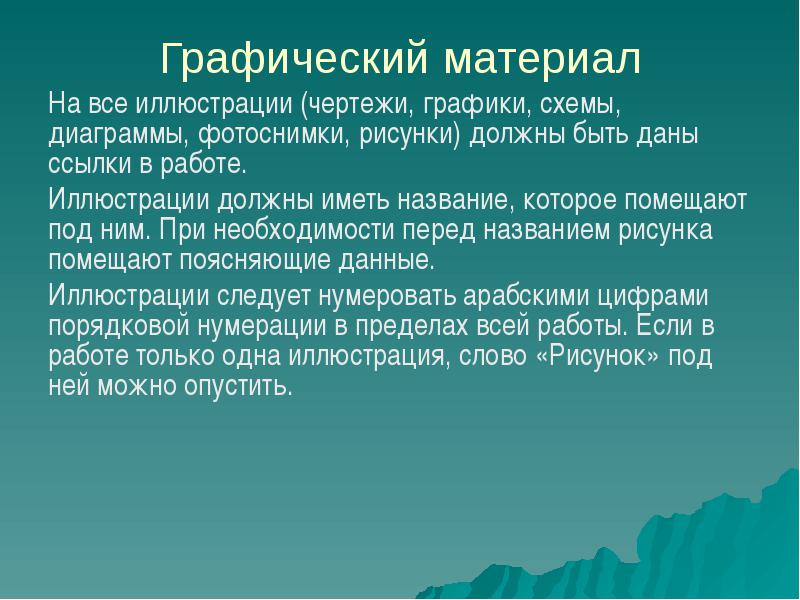
The introduction should include a statement of the research problem. This section expands on the research question that you hope to answer in your research. He should also provide a preliminary answer to this question - what do you hope or expect to find. It should also contain your rationale. Rationale refers to how you came to the conclusion that this research should be undertaken. What was your line of reasoning? Why is it important to do this research as a statement of logic rather than a statement of faith?
This section indicates the practical significance of the problem, indicates what the current state of affairs is and what is unsatisfactory. This section defines terms and concepts that are important to your topic. It provides readers with a link to terms that may be technical or have multiple meanings, thus avoiding possible misinterpretation. It defines terms in the context where they will be used and organized like a dictionary. If there are references to literature for certain definitions, they should be presented in the appropriate format.
All tables should be referenced in the text.
Tables should be numbered with Arabic numerals. The number should be placed in the upper right corner above the table heading after the word “Table”.
Each table should have a heading that is placed below the word "Table". The word "Table" and the heading begin with a capital letter, no full stop at the end of the heading.
Column headings are indicated in the singular.
The column "No. p / p" should not be included in the table.
The table should be placed so that it can be read without turning the work, if such placement is not possible, the table should be positioned so that it can be read by turning the work clockwise.

Links
References to tables, figures, appendices are taken in parentheses, for example, (see appendix 2). When referring, one should write “in accordance with the data in Table 5”, “in accordance with the data in Figure 3”.
When referring to a work, after mentioning it in the text of the work, put in square brackets the number under which it appears in the list of references. Where necessary, usually when using digital data or citations, the pages on which the source used are placed are also indicated, for example, if links to several sources are used, they are separated in square brackets by a semicolon, for example,.
This section provides a comprehensive and solid foundation for the problem you are researching and puts the problem in a broader historical perspective. In the continuous narrative of the literature review, you discuss the research that has already been done and is currently underway, evaluating and evaluating the value of various theories, arguments, projects, and authors to your project. Don't give your opinion and cite research that agrees with you. In fact, leave all personal links and opinions.
Use this section to objectively formulate and evaluate research that has already been done on your topic. This section not only looks at how and why your research will narrow in scope, but it also explains what you are not learning and why you cannot or don’t want to. This is the area that narrows your topic down in time, place, and content. For example, your topic will not include data from an entire story in all locations and from all people, but perhaps to seventh graders in the same school district for one school year.
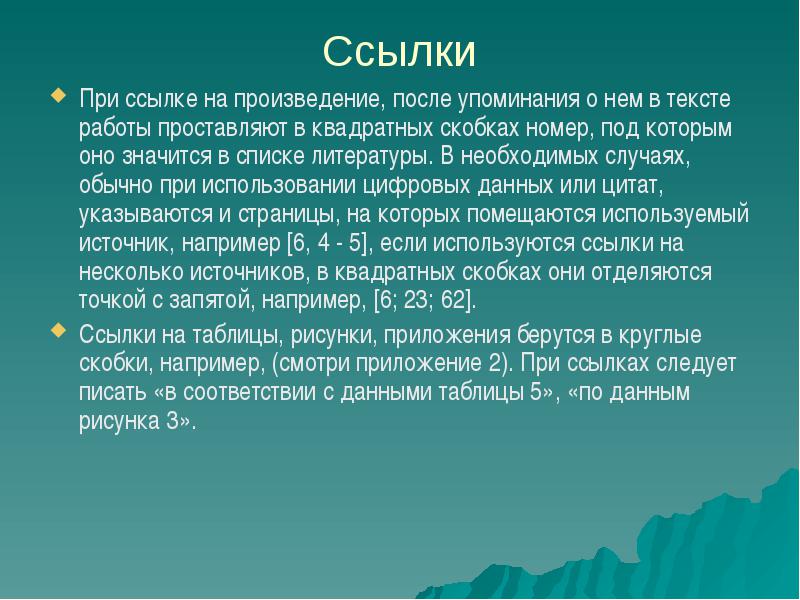
Registration of research work
The text of the work is printed on standard A4 pages of white paper (210 × 297 mm, horizontal - 210 mm).
Font - type Times New Roman, size 12 pt, line spacing 1.5, margins: left - 30 mm, right - 15 mm, top and bottom - 20 mm. Handwriting of individual fragments (formulas, drawing material, etc.), which are performed with black paste (ink), is acceptable.
Scope of work no more 15 pages (not counting the title page and table of contents).
Applications should be numbered and titled. The text should contain links to them.
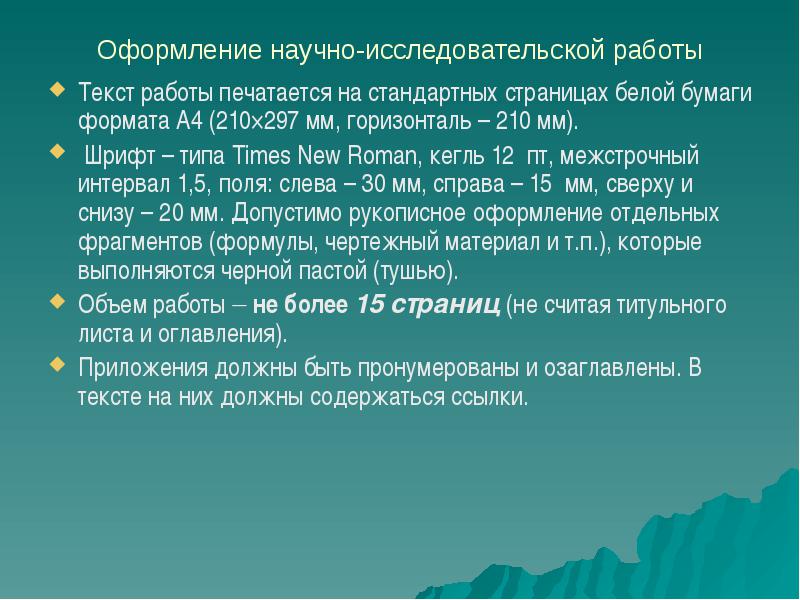
Numbering of pages and chapters
The pages of the work should be numbered in Arabic numerals, observing continuous numbering throughout the text. The page number is placed at the bottom of the page without a dot at the end.
The title page and table of contents are included in the general numbering. The page number is not put on the title page and table of contents.
Illustrations and tables located on separate sheets are included in the general page numbering.
Chapters, paragraphs, paragraphs and sub-paragraphs (except for the introduction, conclusion, list of sources and applications) are numbered in Arabic numerals, for example: chapter 1, paragraph 2.1.
Chapter headings, as well as the words "Introduction", "Conclusion", "References" should be placed in the middle of a line without a period at the end and typed in capital letters, without underlining, trimming from the text with one line spacing.
Word hyphenation in the title is not allowed.
The work and attachments are bound together with the title page (binder and plastic files are recommended).
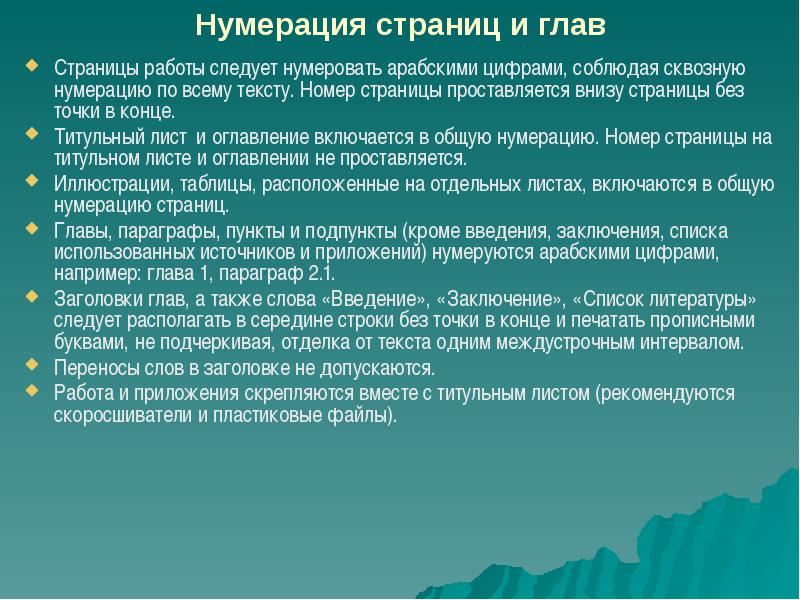
Structure of theses
Basically, the theses repeat the structure of the work. They should include: 1. Statement of the problem.
2. The degree of its knowledge in modern science.
3. Determination of the subject and object of the presented research.
4. Brief description of sources (for works in the humanitarian direction).
5. The purpose of the study, its tasks.
6. Specification of the conclusions for each part of the report, which is aimed at the consistent achievement of a particular task. Thus, the logic of the construction of the work and research methods are shown.
7. General conclusion on the problem, in which the novelty of the research must be emphasized.
Abstracts should contain only text (no graphs, tables, formulas, figures, references).
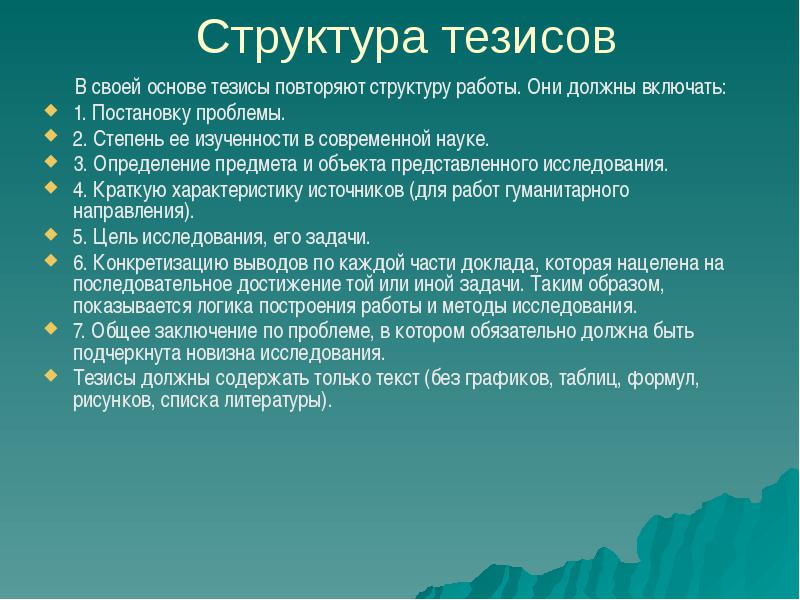
Registration of abstracts
The volume of abstracts is up to 1.5 pages. Text is printed on standard A4 white paper pages. Font - Times New Roman Cyr, size - 12, line spacing - 1.5. Margins: top and bottom - 20 mm, left - 30 mm, right - 15 mm. The abstracts are printed in the following order: the title of the work, in the middle - the author's surname and name, the next line - the place of study, the name of the settlement, below the abstracts themselves. In this case, the text should not contain paragraph indents, alignment, line breaking, line wrapping, word wrapping. Each paragraph should be separated from the other with a blank line.
You can also exclude those seventh graders who move to the school district mid-year. This section describes how the information will be obtained and tested. For a suggestion, you have no results, but you can predict what you will find.
Write a paragraph about the conclusions you hope or expect to draw, or what you hope or expect to find. You don't have results yet, but you can discuss how your results might matter. The reference list must contain complete reference documentation for all articles and text referred to in the proposal. One of the most common formatting mistakes is using all words in link titles.
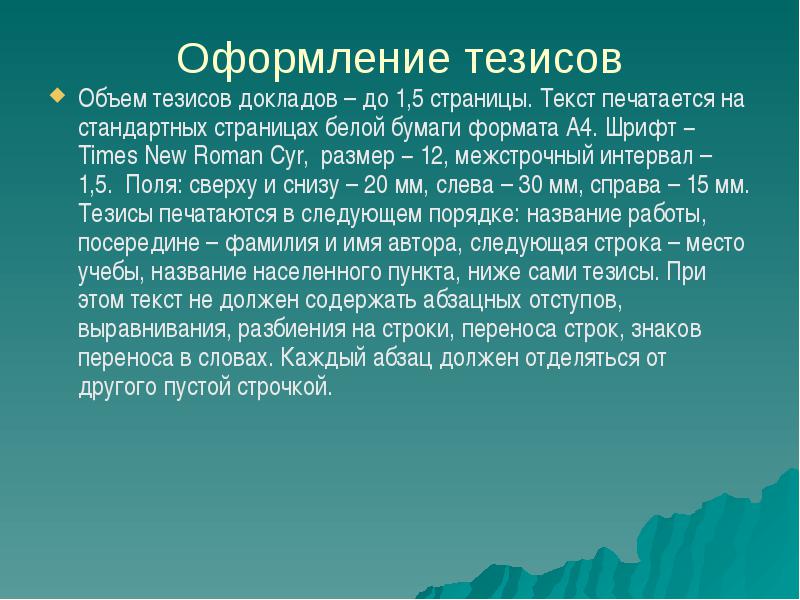
Sample of abstracts
1. Statement of the problem.
2. The degree of its knowledge in modern science.
3. Determination of the subject and object of the presented research.
4. Brief description of sources (for works in the humanitarian direction).
5. The purpose of the study, its tasks.
6. Specification of the conclusions for each part of the report, which is aimed at the consistent achievement of a particular task. Thus, the logic of the construction of the work and research methods are shown.
7. General conclusion on the problem, in which the novelty of the research must be emphasized.
Abstracts should contain only text (no graphs, tables, formulas, figures, references).
The volume of abstracts is up to 1.5 pages. Text is printed on standard A4 white paper pages. Font - Times New Roman Cyr, size - 12, line spacing - 1.5. Margins: top and bottom - 20 mm, left - 30 mm, right - 15 mm. The abstracts are printed in the following order: the title of the work, in the middle - the author's surname and name, the next line - the place of study, the name of the settlement, below the abstracts themselves. In this case, the text should not contain paragraph indents, alignment, line breaking, line wrapping, word wrapping. Each paragraph should be separated from the other with a blank line.
You can also exclude those seventh graders who move to the school district mid-year. This section describes how the information will be obtained and tested. For a suggestion, you have no results, but you can predict what you will find.
Write a paragraph about the conclusions you hope or expect to draw, or what you hope or expect to find. You don't have results yet, but you can discuss how your results might matter. The reference list must contain complete reference documentation for all articles and text referred to in the proposal. One of the most common formatting mistakes is using all words in link titles.
Determination of caffeine in tea and coffee by TLC
Bondarenko Roman
Grade 9 student, secondary school № 12, Nevinnomyssk
Coffee is one of the oldest drinks on earth. Some Ethiopian tribes crushed coffee beans, mixed with fat and rolled into balls. This food possessed stimulating properties, helped to survive in harsh natural conditions. In England in the 17th century, coffee was considered a universal medicine.
A good research proposal will provide you with a great skeleton for your research project... After you finish processing the data and analyzing the data, the next and final step is to draft a written draft of your research. Writing scientific research work is the most important part because it needs more attention than the other seven stages of the research process. When writing a research paper, it is necessary to look for some of the basic elements of the research paper that are required to write.
In the homeland of tea, in China, originally tea was used only as a medicine, then as a ritual drink, and quite recently, it has become a household food drink.
Objective: to determine the caffeine content in coffee and tea by thin layer chromatography. Research object: various types of coffee and tea. Research subject: definition of caffeine. 
Title Annotation Introduction Theoretical background and literature review Methods or procedure Research results Conclusion or discussion Bibliography or references. Title: The title of the research paper should be simple and informative. It should directly attack your research question and should be appropriate enough to explain your domain and the methodology that you will be using.
Abstract: An abstract is actually a short summary of all your research work. Its standard length is between 100 and 500 words. It should include the goals and objectives of your research paper, a short introduction of what was in your research proposal, and emphasize what the end results or completion of your research paper will be. In the final research project, this is the second element, but it is always written at the end when you are done with all your research.
Speech text template
Dear members of the jury, young researchers! We present to your attention the results of research on the topic …………………………… ... Rapid scientific and technological progress and high rates of development of various branches of science and the world economy in the XX century led to a sharp increase in consumption of various …………… ……… .. (the relevance of the research is described, the research problem is formulated). Finding ways to solve this problem became the goal of our research ………………………. We have decided on the tasks of our research: (the tasks of the research are listed) ……………… ... etc. The first task of our research was ……………………………… The first chapter of our research is devoted to the solution of this task, where we presented the theoretical justification for …………………., And also studied …………… and the need use …………… .. at the moment. So we came to the following conclusions: …………………………… To solve the second task of our research: studying the methods of conducting ………………, first we got acquainted with the analysis of the consequences of ……………… and only after that, we began to study modern techniques …………., which was summarized in the second chapter of our study and came to the following conclusions: ……………………………… .. The second chapter of our study suggested the most optimal way ………………………… .. In the third chapter we studied …………… We chose the path by which it is possible to determine …………………… The conclusions of the experimental part are as follows: …… ...... ............................................. The formulated conclusions allow us to judge about that the goal of the study has been achieved. However, this is not the end of our research, it sets before us a new task - to find the reason for …………, namely to determine …………., Compare …………. and calculate. But this will be another study. Thank you for attention. Your questions.